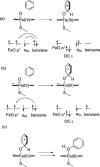Quantum mechanics/molecular mechanics modeling of regioselectivity of drug metabolism in cytochrome P450 2C9
- PMID: 23641937
- PMCID: PMC3670427
- DOI: 10.1021/ja402016p
Quantum mechanics/molecular mechanics modeling of regioselectivity of drug metabolism in cytochrome P450 2C9
Abstract
Cytochrome P450 enzymes (P450s) are important in drug metabolism and have been linked to adverse drug reactions. P450s display broad substrate reactivity, and prediction of metabolites is complex. QM/MM studies of P450 reactivity have provided insight into important details of the reaction mechanisms and have the potential to make predictions of metabolite formation. Here we present a comprehensive study of the oxidation of three widely used pharmaceutical compounds (S-ibuprofen, diclofenac, and S-warfarin) by one of the major drug-metabolizing P450 isoforms, CYP2C9. The reaction barriers to substrate oxidation by the iron-oxo species (Compound I) have been calculated at the B3LYP-D/CHARMM27 level for different possible metabolism sites for each drug, on multiple pathways. In the cases of ibuprofen and warfarin, the process with the lowest activation energy is consistent with the experimentally preferred metabolite. For diclofenac, the pathway leading to the experimentally observed metabolite is not the one with the lowest activation energy. This apparent inconsistency with experiment might be explained by the two very different binding modes involved in oxidation at the two competing positions. The carboxylate of diclofenac interacts strongly with the CYP2C9 Arg108 side chain in the transition state for formation of the observed metabolite-but not in that for the competing pathway. We compare reaction barriers calculated both in the presence and in the absence of the protein and observe a marked improvement in selectivity prediction ability upon inclusion of the protein for all of the substrates studied. The barriers calculated with the protein are generally higher than those calculated in the gas phase. This suggests that active-site residues surrounding the substrate play an important role in controlling selectivity in CYP2C9. The results show that inclusion of sampling (particularly) and dispersion effects is important in making accurate predictions of drug metabolism selectivity of P450s using QM/MM methods.
Figures



















Similar articles
-
QM/MM modeling of benzene hydroxylation in human cytochrome P450 2C9.J Phys Chem A. 2008 Dec 18;112(50):13149-56. doi: 10.1021/jp8016908. J Phys Chem A. 2008. PMID: 18754597
-
Substrate selectivity of human cytochrome P450 2C9: importance of residues 476, 365, and 114 in recognition of diclofenac and sulfaphenazole and in mechanism-based inactivation by tienilic acid.Arch Biochem Biophys. 2003 Jan 1;409(1):80-91. doi: 10.1016/s0003-9861(02)00548-9. Arch Biochem Biophys. 2003. PMID: 12464247
-
Diclofenac and its derivatives as tools for studying human cytochromes P450 active sites: particular efficiency and regioselectivity of P450 2Cs.Biochemistry. 1999 Oct 26;38(43):14264-70. doi: 10.1021/bi991195u. Biochemistry. 1999. PMID: 10572000
-
New insights into the structural features and functional relevance of human cytochrome P450 2C9. Part I.Curr Drug Metab. 2009 Dec;10(10):1075-126. doi: 10.2174/138920009790820129. Curr Drug Metab. 2009. PMID: 20167001 Review.
-
Substrates, inducers, inhibitors and structure-activity relationships of human Cytochrome P450 2C9 and implications in drug development.Curr Med Chem. 2009;16(27):3480-675. doi: 10.2174/092986709789057635. Epub 2009 Sep 1. Curr Med Chem. 2009. PMID: 19515014 Review.
Cited by
-
Developing Structure-Activity Relationships for N-Nitrosamine Activity.Comput Toxicol. 2021 Nov;20:100186. doi: 10.1016/j.comtox.2021.100186. Epub 2021 Sep 8. Comput Toxicol. 2021. PMID: 34901581 Free PMC article.
-
Quantum-inspired computational drug design for phytopharmaceuticals: a herbal holography analysis.J Mol Model. 2025 Jun 13;31(7):188. doi: 10.1007/s00894-025-06412-w. J Mol Model. 2025. PMID: 40512383 Review.
-
Antihypertensive drugs metabolism: an update to pharmacokinetic profiles and computational approaches.Curr Pharm Des. 2015;21(6):806-22. doi: 10.2174/1381612820666141024151119. Curr Pharm Des. 2015. PMID: 25341854 Free PMC article. Review.
-
Dynamics underlying hydroxylation selectivity of cytochrome P450cam.Biophys J. 2021 Mar 2;120(5):912-923. doi: 10.1016/j.bpj.2021.01.027. Epub 2021 Feb 3. Biophys J. 2021. PMID: 33545101 Free PMC article.
-
1-Nitropyrene Metabolism and Health Risk: Identification of Key Enzymes, Pathways, and Metabolites Using a Multimethod Approach.Environ Health (Wash). 2023 Oct 5;1(6):383-393. doi: 10.1021/envhealth.3c00064. eCollection 2023 Dec 15. Environ Health (Wash). 2023. PMID: 39474049 Free PMC article.
References
-
- Ortiz de Montellano P. R., Ed. Cytochrome P450: Structure, Mechanism, and Biochemistry, 3rd ed.; Kluwer Academic/Plenum Publishers: New York, 2005.
-
- Lonsdale R.; Harvey J. N.; Mulholland A. J. In Iron-Containing Enzymes: Versatile Catalysts of Hydroxylation Reactions in Nature; de Visser S. P., Kumar D., Eds.; RSC Publishing: Cambridge, UK, 2011; Chapter 11, pp 366–399.
-
- de Graaf C.; Vermeulen N. P. E.; Feenstra K. A. J. Med. Chem. 2005, 48, 2725–2755. - PubMed
-
- Bathelt C. M.; Ridder L.; Mulholland A. J.; Harvey J. N. Org. Biomol. Chem. 2004, 2, 2998–3005. - PubMed
Publication types
MeSH terms
Substances
Grants and funding
LinkOut - more resources
Full Text Sources
Other Literature Sources
Molecular Biology Databases

